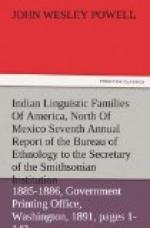Along the west coast of Greenland, Eskimo occupancy extends to about 74 deg.. This division is separated by a considerable interval of uninhabited coast from the Etah Eskimo who occupy the coast from Smith Sound to Cape York, their most northerly village being in 78 deg. 18’. For our knowledge of these interesting people we are chiefly indebted to Ross and Bessels.
In Grinnell Land, Gen. Greely found indications of permanent Eskimo habitations near Fort Conger, lat. 81 deg. 44’.
On the coast of Labrador the Eskimo reach as far south as Hamilton Inlet, about 55 deg. 30’. Not long since they extended to the Straits of Belle Isle, 50 deg. 30’.
On the east coast of Hudson Bay the Eskimo reach at present nearly to James Bay. According to Dobbs[36] in 1744 they extended as far south as east Maine River, or about 52 deg.. The name Notaway (Eskimo) River at the southern end of the bay indicates a former Eskimo extension to that point.
[Footnote 36: Dobbs (Arthur).
An account of the Countries adjoining
to Hudson’s Bay.
London, 1744.]
According to Boas and Bessels the most northern Eskimo of the middle group north of Hudson Bay reside on the southern extremity of Ellesmere Land around Jones Sound. Evidences of former occupation of Prince Patrick, Melville, and other of the northern Arctic islands are not lacking, but for some unknown cause, probably a failure of food supply, the Eskimo have migrated thence and the islands are no longer inhabited. In the western part of the central region the coast appears to be uninhabited from the Coppermine River to Cape Bathurst. To the west of the Mackenzie, Herschel Island marks the limit of permanent occupancy by the Mackenzie Eskimo, there being no permanent villages between that island and the settlements at Point Barrow.
The intervening strip of coast is, however, undoubtedly hunted over more or less in summer. The Point Barrow Eskimo do not penetrate far into the interior, but farther to the south the Eskimo reach to the headwaters of the Nunatog and Koyuk Rivers. Only visiting the coast for trading purposes, they occupy an anomalous position among Eskimo.
Eskimo occupancy of the rest of the Alaska coast is practically continuous throughout its whole extent as far to the south and east as the Atna or Copper River, where begin the domains of the Koluschan family. Only in two places do the Indians of the Athapascan family intrude upon Eskimo territory, about Cook’s Inlet, and at the mouth of Copper River.
Owing to the labors of Dall, Petroff, Nelson, Turner, Murdoch, and others we are now pretty well informed as to the distribution of the Eskimo in Alaska.
Nothing is said by Gallatin of the Aleutian Islanders and they were probably not considered by him to be Eskimauan. They are now known to belong to this family, though the Aleutian dialects are unintelligible to the Eskimo proper. Their distribution has been entirely changed since the advent of the Russians and the introduction of the fur trade, and at present they occupy only a very small portion of the islands. Formerly they were much more numerous than at present and extended throughout the chain.




